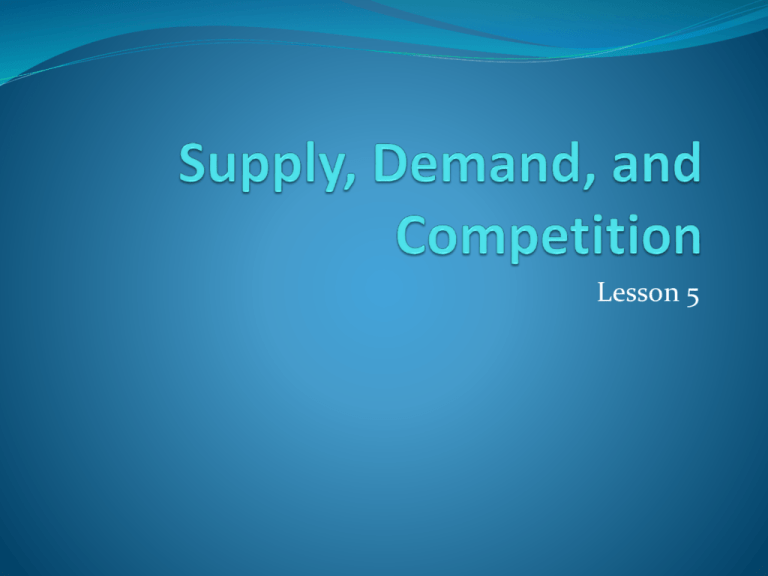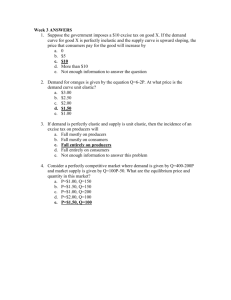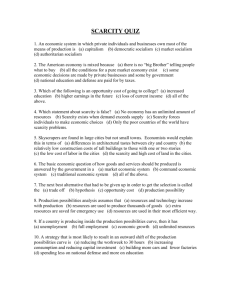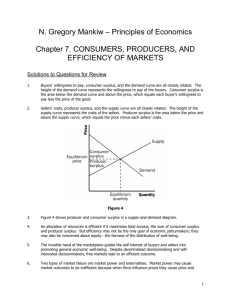Supply and Demand
advertisement

Lesson 5 Businesses use supply and demand to decide what products to produce and how to price products and services. Producers and Consumers The economy of the United States is based on providing consumers with the goods and services they need and want. Consumers are the people who buy and use goods and services. Producers are the people and businesses that provide these goods and services for the consumers. The goods and services made available to consumers are determined by supply and demand. Supply and Demand Supply is the number of items ready for sale. Demand is the number of items consumers want to purchase. Supply Curve As prices increase, the supply available also increases. As prices decrease, the supply available also decreases. Direct relationship Demand Curve As price of an item increases, the quantity demanded decreases. As the price of an item decreases, the quantity demanded increases. Indirect or inverse relationship. Law of Supply and Demand The price of an item will go down if the supply increases or the demand for that item decreases. 2. The price of an item will go up if the supply decreases or the demand for that item increases. 1. Equilibrium Price The price at the point where they cross is important because consumers will demand the same amount that producers will supply at that price. Market Clearing Price— The price at which all of the products or services brought to market is consumed. Surplus and Scarcity Surplus Scarcity If the supply of an item is When the consumers’ greater than its demand by consumers, then there is a surplus of that item. A surplus causes the price of the item to decrease. demand for the item is greater than the supply, this results in a scarcity. Scarcity causes the price of the item to increase. Surplus Supply The surplus in the graph to the left is the triangle space above the supply curve and below the demand curve. Demand Early Examples of Supply and Demand Jamestown Colony prospered from tobacco production. Tobacco sold for very high prices in England due to the high demand for the product. This encouraged settlers to plant more tobacco to take advantage of the high prices. Early Examples of Supply and Demand In 1849, gold was discovered in California. People from all over the world rushed to CA to get rich in the gold fields. With limited supplies of goods and services available to the prospectors, the prices of items such as food, lodging, and supplies skyrocketed. Early Examples of Supply and Demand After the Civil War, small farms operated by sharecroppers and tenant farmers replaced the large plantations. With few resources, the farmers depended on credit to purchase the goods and services they needed. To repay their debts, farmers grew cotton as a cash crop. Eventually more cotton was produced than could be sold, and the price of cotton fell drastically. Today The cost of energy is a concern for consumers. One form of energy is fossil fuels. Oil is a fossil fuel that is a nonrenewable resource. There is a limited supply available. As other nations build more factories, drive more cars, and buy more computers, the rising demand for oil causes an increase in oil prices. Future demand by individuals, businesses, and nations for fossil fuels will continue to cause increases in the price of fossil fuels, unless the demand can be satisfied by alternative energy sources. Video- Supply and Demand Supply and Demand Competition Competition— Competition occurs when more than one business offers the same good or service. Competition increases production and efficiency because it motivates a business to offer goods at better prices or a better quality than their competitors. For this reason, when many businesses are competing with each other for customers, the prices of goods or services often go down. On the other hand, when there is no competition, a business can charge any price it wants for a good or service. Competition is very important to the economy. Productivity Productivity— The measurement of efficiency by comparing output produced by a business to the resources, labor, and capital put in to producing goods. Businesses always have an incentive to improve their productivity. With increased productivity, a firm can use fewer resources to create the same amount of goods. A firm will then be able to spend more on resources, such as labor and materials. In turn, the firm will be able to increase its output and/or reduce its price. This will increase the supply of the good, which will reduce the price consumers pay. The Effects of Competition Technological innovations in the 20th century changed the way of life for many people. Jobs that were previously complex or time consuming became simpler because of new technology. People were able to do more things in a shorter period of time both at work and in their homes. These innovations increased the average person's productivity. A person's increased productivity and ability to handle tasks more easily created an increase in standard of living. The Effects of Competition In a market economy, consumers dictate what is produced and how much they are willing to pay for the products. If they feel a good is over-priced or isn't useful, they will not purchase it. Businesses have to respond to consumers' actions or face going out of business. In this way, businesses are encouraged to keep prices low and continuously improve their products. With more quality goods available, consumers will experience a higher standard of living. Other Important Terms Standard of Living— The level of material comfort of a people or nation as measured by the goods, services, and luxuries available to them. Free Enterprise System— An economic system in which the people and businesses work together to conduct economic activity with no government involvement. When the United States government was being formed, people were eager to set up this type of system because they didn't want the government interfering with the economy. Video- The Way We Live-Working World: The Economy and Work The Way We Live-Working World: The Economy and Work











